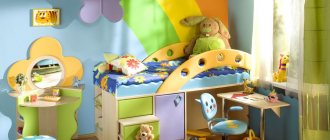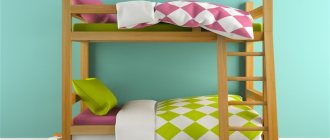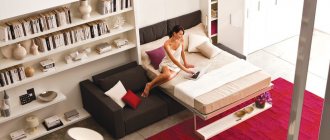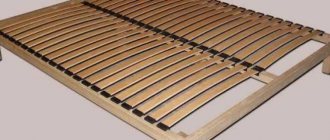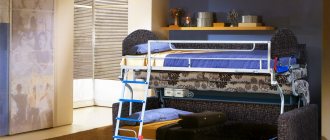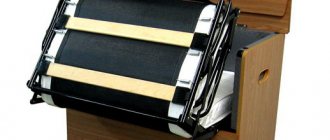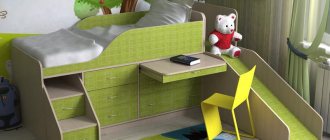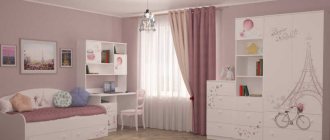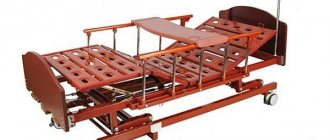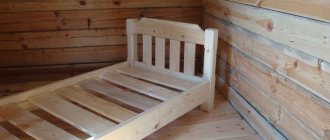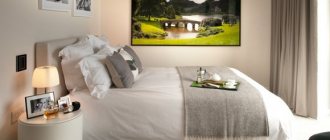What is a bunk bed
A bunk bed is a practical and useful piece of furniture consisting of two tiers.
The upper tier is usually adapted for a sleeping place, and the lower one can be used as an identical or different bed, a folding or standard sofa, an armchair, open shelves, a computer desk and even a small closet. Bunk beds are indispensable in families with several children, because they allow you to properly organize the space in the room. But for parents with one child, such a bed can be an excellent solution if the apartment area is small.
Types of bunk beds
Do not think that compact bunk beds are produced exclusively
for children and only to save space. All over the world, in armies or in youth chalet/hostel hotels, it is customary to place guests in such interesting rooms. Firstly, such beds are at least non-trivial, and secondly, they are very entertaining for young people.
Therefore, bunk beds can be classified into different types:
- number of zones (playing, educational, sleeping, physical education);
- number of beds;
- age;
- material.
First of all, such beds are popular among children. Even if there is only one child in the family, a bunk bed can contain one sleeping place. The second zone, which is located on the first floor, is a working or physical training zone. And this is very interesting, because at this age a child perceives everything as a game. Agree, it’s much more fun to go down from the second floor using a rope ladder like
Indiana Jones to do your homework than just sit down at your desk.
If there are two or more children in a family, then bunk beds help them become friends, they will spend time together more often when they sleep, study or play.
Most companies produce teenage-type beds to save money. It is larger in size than a standard bed for children, and can be combined to suit height. Some models provide for turning a baby's cradle into a work desk, and the sofa area into a bed. Ergonomics allows you to combine zones in a convenient way without taking up much space, especially if the bed contains a built-in wardrobe or secret drawers.
Therefore, if you are aiming to make a bed yourself, then consider different options, which will differ in complexity and cost.
Types and features of children's models
Modern manufacturers have recently increasingly expanded their product line of bunk beds. Many interesting varieties have appeared, which in each individual case solve certain problems to improve the ergonomics of the living space.
It is advisable to classify all bunk beds according to the following criteria:
- material of manufacture;
- design and device;
- location of sleeping places;
- form;
- height;
- age and gender of children, etc.
Wooden (solid wood), metal, combined
Most bunk beds are made of wood, because this natural material is environmentally friendly and easy to process, which allows you to implement any design solutions. Wood has many advantages. The best options are models made of beech, alder or oak, but pine products, despite their reasonable cost, are not as durable as analogues made from other wood and will last much less.
Metal bunk beds are more reliable and durable, thanks to which they have an impressive service life. However, they do not have an intricate design and are expensive, which significantly reduces their popularity. In addition, this option is not suitable for every room, because the metal structure looks massive and visually weighs down the interior of the nursery.
The best option for a bunk bed is a combination one, which combines the strength of metal and the warmth of wood. Combined models are the most convenient due to their versatility. The tandem of elements from different materials in one piece of furniture significantly increases its functionality.
Straight, angular
A bunk corner bed, if you look at it from the height of the ceiling, resembles the shape of the letter “L”. It is a structure consisting of an upper standard bed and a lower part located perpendicularly. Such models most often have increased functionality. A sports complex (wall bars, rings, rope) is built into them, allowing children to spend time with health benefits, as well as a desk or niches for storing things, which help not to clutter up the entire room with diverse and bulky furniture.
But this variety also has disadvantages. This option is not the most practical in terms of saving space and takes up a decent amount of space in the children's room. The advantage is that such designs can have not two, but more sleeping places, which is a suitable solution for families with several children.
Straight beds with two tiers are standard models in which the sleeping place is on top, and either another bed or a useful device, for example, a wall, is located below. This option is a bed with furniture attached to it, consisting of several cabinets, shelves, a chest of drawers and even a desk. The main advantage of the model is that it allows you to improve the ergonomics of the space and create an interior in the same style in the room. One of the disadvantages is the large dimensions of the structure.
Stationary, retractable
Stationary beds with two levels can also consist of two beds or be designed in the form of a “loft” bed, when the bed is directly at the top and useful pieces of furniture (table, wall, etc.) below. However, such a bed has a significant disadvantage - it does not transform and takes up quite a lot of space.
Another thing is a retractable (roll-out) bed, the upper part of which is a high sofa, and the lower part is a retractable platform with an additional sleeping place.
Thus, when unfolded, the bed is equipped with two sleeping places, and when folded, it resembles the shape of an ordinary bed or sofa. The main advantage of the design is its compactness and the absence of stairs; the disadvantage is the small number of auxiliary devices.
There are models on sale where the lower tier bed is equipped with an additional third bed.
Low (low), high
All bunk beds are divided according to height into low and high. And the choice in this case will directly depend on the height of the ceiling in the room. The most comfortable distance between the sleeping place and the ceiling should not be less than 90 cm.
With a regular ladder, with a ladder-boxes
Most types of beds with two tiers are equipped with special stairs that make it easy to get from the first “floor” to the second. In some models, the staircase is simple, consisting of a support and rungs. In others, it is more functional, when there are special compartments for storing things between the steps.
With sides on the lower tier, without sides
Photo: Children's bunk bed with an adjustable lower side
When choosing a bed, you should also focus on the age of the children. If one of them is too small, then for its safety it is advisable to purchase a bed with high sides on the lower tier, which will protect it from falling.
For older children, such design solutions are irrelevant.
With table (work area)
The most popular among parents is the “loft” bed, where there is one sleeping place in the upper part, and below there is a work area (desk, desk or computer table). This piece of furniture is relevant for small rooms where it is not possible to fully arrange the furniture.
Transformable bunk wardrobe bed
Another useful multifunctional option for small spaces, allowing you to transform one or both beds into a closet. This solution is optimal for studio apartments, because it allows you not only to save space, but also not to have to look for a suitable place to store bed linen.
For girls, for boys
When purchasing a bed, you should also consider the gender of the child. For boys, designs with wall bars and other sports equipment are more suitable. Girls are more likely to focus on attractive appearance rather than functionality. As a rule, they prefer beds where the lower tier is a comfortable sofa.
Pros and cons of bunk beds for children
It is advisable to consider the advantages and disadvantages of bunk beds depending on the specific model. But different types of construction also have common advantages:
- Saving. In this case, we are talking not just about saving space, but also about relatively low acquisition costs. If you buy several beds per room or separate pieces of furniture, the cost will be higher.
- Versatility. A bunk bed is suitable for children of any age and gender.
- Ergonomics. The design with two tiers helps to properly organize the space even in a small room. Moreover, some models can replace an entire furniture set for a child’s room.
It is worth considering the disadvantages separately:
- increased risk of injury. Some children use bunk beds for play, which often poses a risk of falling from a height.
- massiveness. On the one hand, the design with two levels helps to save space in the room, on the other hand, it is very difficult to move, assemble and disassemble it yourself.
Additional functionality of loft beds for babies
When choosing a bed with two tiers, you need to pay attention to the additional practical features of the furniture. Thus, on the furniture market there are models that have drawers under the lower sleeping surface that pull out to store toys or bed linen; ideally, these pull-out systems are equipped with wheels. A good additional option is built-in lighting, which can be used for a night light.
Loft beds allow you to properly arrange the space of a not very large children's room, effectively using every square meter. A good and thoughtful selection of sleeping furniture will ensure sound sleep and a fun time for your children while they are awake!
Wallpaper for the Bedroom The choice is huge But what to choose?
Dimensions of a children's bunk bed
Dimensions are no less important for a comfortable sleep. As a rule, designs in furniture stores have standard sizes. But some suppliers make beds taking into account the individual characteristics of the child.
Standard dimensions (length, width, height)
Classic bunk beds have the following standard sizes, depending on the age of the child:
| Age | Dimensions, cm |
| up to 3 years | 120x60 |
| from 3 to 6-7 years | 140x70, 150x70 |
| from 7 to 14 years | 160x80, 170x80 |
| over 14 years old | 180x90, 190x90 |
As for the height, it depends on the height of the ceilings. The best option is a height of 1.65-1.75 m.
Non-standard models
Non-standard bed parameters are determined taking into account the child’s height and build:
- the length of the sleeping place can be calculated using the following formula: the child’s height in cm plus 30-40 cm;
- the width is determined based on the position when the child lies on his back with his elbows bent and his arms spread to the sides, while his hands are closed on his stomach. It should also be taken into account that the distance between the elbows and the edges of the mattress should not be less than 10 cm.
Bunk bed height
When choosing a bunk bed, you need to consider the overall height of the product. The bed should not be too high so that the child sleeping on the second tier has enough free space and does not feel like he is sleeping almost under the ceiling. The standard height of a bed in two tiers is usually 165 - 175 cm. With such dimensions, a child whose sleeping place is located on the “second floor” will not feel in a confined space, even with a standard ceiling height of 2.6 meters.
Distance between tiers
Another parameter, also very important when choosing bunk beds for children, is the distance between the crossbar of the lower tier and the lower surface of the upper tier. This parameter directly depends on the height of the child sleeping below. It is necessary to take into account the distance between the tiers; a child sitting on the bed should not touch his head to the upper bed. Typically this parameter is 85 – 90 cm.
Bed height from floor
The height of the lower berth from the floor must be sufficient. There are also standards here:
- the height of the bed for preschool children 3-7 years old should be 30 cm;
- the optimal height of the bed for schoolchildren 7 - 14 years old should be 40 cm;
- The height of the bed base for a teenager and an adult should be 50 cm.
Bed with desk
If you want to buy a bunk bed, at the bottom of which there is a workplace with a table, then again you need to take into account the age and height of your child. The distance to the bed from the floor should be such that the child sitting at the desk below is comfortable. The optimal height of such a module is 150 cm.
Stair dimensions
In conclusion, I would like to note that the size of the steps of the stairs along which the child will climb to the second tier should also be comfortable and sufficient. The standard dimensions of the staircase are 40 cm wide, the optimal distance between steps is 20-25 cm. This parameter also depends on the age of the children; the younger the child, the smaller the height of the steps should be.
Customer Reviews
There are many positive reviews on the Internet from parents who decided to purchase a bunk bed for their children. As a rule, many note that it really helps to save space and properly organize the space in the room.
However, you can also find negative reviews about this design on the Internet. Many people note that they are afraid to buy models with two levels for fear of the child falling from a height. Most mothers note as a minus that it is inconvenient to change bed linen on the upper bed.
Buying a bunk bed for a child’s room is a decision that is made by parents individually, taking into account the area of the child’s room, budget, individual characteristics and interests of the child. Despite the variety of models with extensive functionality, this design is not suitable for everyone, because it also has a number of disadvantages.
